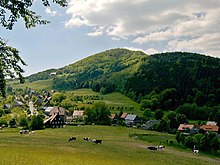Lusatian Mountains
| Lusatian Mountains | |
|---|---|
 Cross-country skiing route along the Lusatian Mountains' main ridge. The background peak is Mt. Luž (Lausche). | |
| Highest point | |
| Peak | Luž (Lausche) |
| Elevation | 793 m (2,602 ft) |
| Geography | |
Lua error in Module:Location_map at line 526: Unable to find the specified location map definition: "Module:Location map/data/Krkonosska oblast.svg" does not exist.
| |
| Countries | Germany and Czech Republic |
| States | Saxony and Bohemia |
| Parent range | Western Sudetes |
| Geology | |
| Rock types | Sandstone and Granite |
The Lusatian Mountains[1] (Template:Lang-cs; Template:Lang-de) are a mountain range of the Western Sudetes on the southeastern border of Germany with the Czech Republic. They are a continuation of the Ore Mountains range west of the Elbe valley. The mountains of the northern, German, part are called the Zittau Mountains.
Geography

The range is among the westernmost extensions of the Sudetes, which stretch along the border between the historic region of Silesia in the north and Bohemia and Moravia in the south up to the Moravian Gate in the east, where they join the Carpathian Mountains. The northwestern foothills of the Lusatian Mountains are called Lusatian Highlands; in the southwest the range borders on the České Středohoří mountains.
The range is largely made up of sandstone sedimentary rocks leaning on a Precambrian crystalline basement. The northern ridge is marked by the Lusatian Fault, a geological disturbance zone separating the Bohemian sandstones from the Lusatian granodiorite. During the Tertiary volcanic magma streams broke through the sandstone layer and solidified into basalt and phonolite. Several sandstone contact areas were also hardened to columns and distinct rock formations.
Both the German (Naturpark Zittauer Gebirge) and the Czech (ChKO Lužické hory) parts nowadays are protected areas according to IUCN guidelines.
Notable mountains


The highest peak is Lausche (Luž) 793 m. Other notable peaks include Pěnkavčí vrch 792 m, Jedlová 774 m, Klíč 760 m, Hvozd 750 m and Studenec 736 m.
- Lausche (Luž), 793 m
- Pěnkavčí vrch (Finkenkoppe), 792 m
- Jedlová (Tannenberg), 774 m
- Klíč (Kleis), 760 m
- Hochwald (Hvozd), 750 m
- Studenec (Kaltenberg), 736 m
- Stožec (Großer Schöber), 665 m
- Jezevčí vrch (Limberg), 665 m
- Střední vrch (Mittenberg), 593 m
- Malý Stožec (Kleiner Schöber) 659 m
- Zlatý vrch (Goldberg), 657 m
- Chřibský vrch (Himpelberg), 621 m
- Sokol (Falkenberg), 592 m
- Töpfer, 582 m
- Popova skála (Pfaffenstein), 565 m
- Ortel (Ortelsberg), 554 m
- Zámecký vrch (Schlossberg), 530 m
- Mount Oybin, 514 m
See also
References
- ^ Lusatian Mountains at www.luzicke-hory.cz (accessed 29 Apr 2011).


